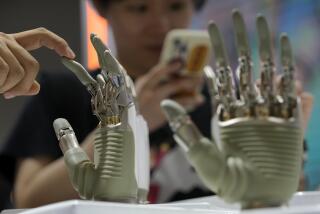Chinese and American cultures clash in ‘American Factory’ documentary
Labor issues have been a primary focus for documentary filmmakers Julia Reichert and Steven Bognar. The couple, partners in work and life, have not had to look far for subjects. They live near Dayton, Ohio, in the heart of the postindustrial Midwest, the so-called Rust Belt where decades of economic decline hit a new low in the aftermath of the 2008 recession.
They captured the deep sadness of that moment in the 2009 HBO short “The Last Truck: The Closing of a GM Plant,” which received an Academy Award nomination (Reichert’s third) for its glimpse at the final days of the Moraine Assembly automobile factory.
But the story had another chapter. The filmmakers returned to the plant in 2015 to chart its revival as a Chinese-owned glass factory, shooting more than 1,200 hours of footage over three years to make the complex and volatile “American Factory.”
“It’s only a short drive from our house to get to the plant,” Reichert said. “But we never thought we’d go back in there again.”
The space, which the filmmaker describes as bigger than the Pentagon, was a dream to shoot in. “Those very bright lights that everyone is bathed in, as they inspect the glass, and you see their reflections, you see people passing glass from hand to hand, stacks of glass and beautiful reflections … we were dazzled by that. The first number of times we went in, we just filmed for the beauty of it.”
Thanks to their long and deep associations in the area, the filmmakers were able to get extraordinary access to the factory and its employees and staff and could maintain creative independence from the Chinese corporation Fuyao and its chairman, billionaire Cao Dewang.
Amid so much optimism around the plant’s resurgence, Reichert and Bognar had no idea of the twists ahead. But seasoned and resourceful observers that they are, they sensed the potential.
“The rivalry between China and the United States is one of the big stories of the 21st century,” Reichert said. “How was that going to play out on the factory floor, and with management and with the chairman flying over from China every six to seven to eight weeks? What was that going to look like?”
In “American Factory,” it looks like an age-old culture clash, with American workers scrutinized through the lens of a punishing Chinese work ethic, amid rising tensions over productivity, profit, safety and, most divisive of all, a campaign to unionize. The Chinese workers, a minority at the factory, gamely struggle to feel at home in the Ohio suburbs, forging bonds with American counterparts they can’t always understand.
The filmmakers and their team had to hop over language barriers by bringing on Chinese coproducers who could gain the immediate trust of workers reticent to engage with camera-toting Americans, even through a translator. In one of the most revealing scenes, a worker named Wong He makes dinner and reflects longingly about his family back home, talking openly with a Chinese field producer into the night. Bognar sat nearby with his camera, “not knowing what was being said and hopefully getting a good in-focus shot.”
Reichert said that inclusive perspective, which extended to Cao and other higher-ups at Fuyao, may have been part of what impressed Barack and Michelle Obama, who selected “American Factory” as the first film to be released by their company Higher Ground Productions with Netflix. “They believe that in order to bridge the divide that we see in the country right now, it’s important that we listen to each other and that we learn each others’ stories,” she said. “Our film really tries to be fair to everybody, really tries to listen to everybody.”
“Everyone,” Bognar added, “has more layers to them than a surface-y sketch can convey.”
Even Fuyao chairman Cao, who might have the most to lose from participating, was philosophical. “They were remarkably gracious about it,” Reichert said. “I know they must have squirmed in their seats at certain scenes. He said, ‘You know, we can learn from this.’ “
The reception back home was not so modulated. “It was almost like a Passion play,” said Reichert, recalling the film’s Dayton premiere, just ahead of its late-summer bow on Netflix. A thousand people saw their community, and its livelihood, reflected on the big screen, adding their own groans and gasps to each scene.
In a city shaken by the tragedy of a mass shooting in August, here was a welcome moment to celebrate. “We were still recovering,” Bognar said. “The town has been ferociously committed to getting together, to not retreating, to being out in public together, acknowledging that we’re a town that doesn’t run away from this kind of stuff.”
More to Read
Only good movies
Get the Indie Focus newsletter, Mark Olsen's weekly guide to the world of cinema.
You may occasionally receive promotional content from the Los Angeles Times.









